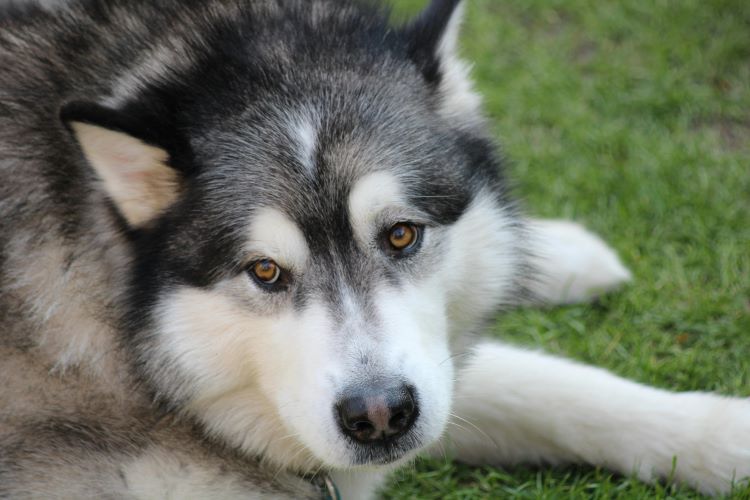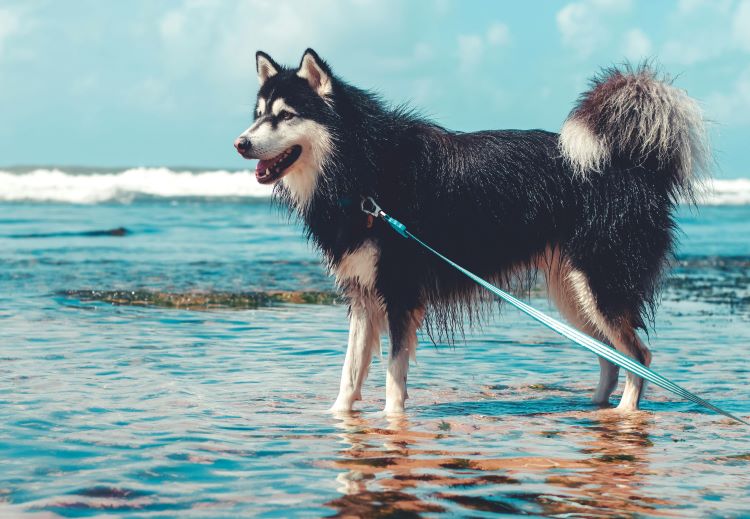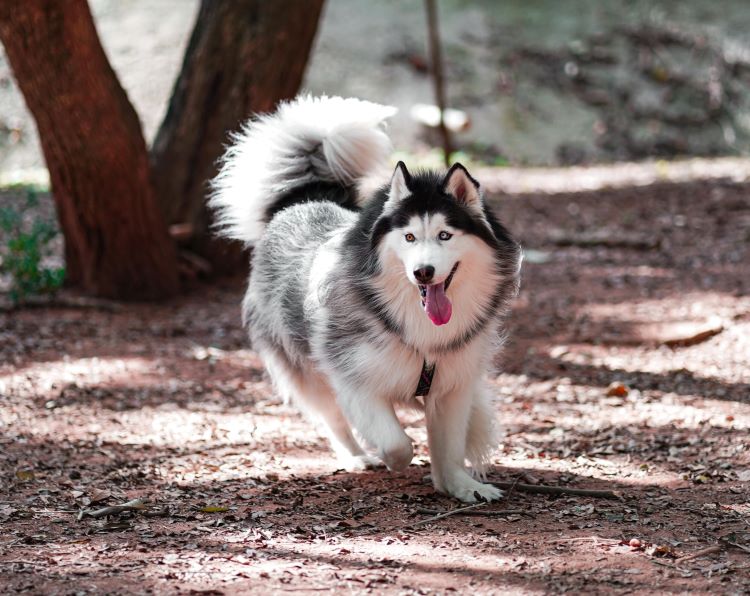Ready to help treat your pet to a healthy life?
The Alaskan Malamute: Breed History, Care Tips & Fun Facts
By : Kathleen Crampton & Trupanion Staff | Published Aug 7, 2025

With their striking appearance and sturdy build, Alaskan Malamutes are one of the most iconic and beloved Arctic sled dog breeds. Though they’re often confused with the Siberian Husky, the Alaskan “Mal” makes people do a double-take with their larger, strong bodies, floofiness, and amiable, goofy expressions (as many dog parents can attest, these dogs can be total clowns). So, what is an Alaskan Malamute, and what should pet parents — or those looking to adopt — know about this breed?
As it turns out, quite a lot! This breed can be a lot of work for dog owners, but there’s also a lot of fun to be had. To give you a better picture, we’ll explore fun facts, history, unique characteristics, personality traits, care needs, and more in this guide. Ready to learn all about the Alaskan Malamute? Let’s take a look!
6 fun facts about Alaskan Malamutes
- The Alaskan Malamute was recognized as the official state dog of Alaska in 2010.
- They’re known for their energy, endurance, and intelligence.
- Although they don’t tend to bark much, Alaskan Mals are quite good at “talking to” their pet parents with “awoos,” whines, or howls.
- Director George Lucas’s dog named Indiana, an Alaskan Malamute, allegedly inspired the Star Wars character Chewbacca.
- An Alaskan Malamute appeared (alongside a Collie) on a 1984 stamp issued by the US Postal Service in celebration of the American Kennel Club’s 100th anniversary.
- The breed can endure very cold temperatures thanks to their double coats and other weather-protecting features.
Breed description
The Alaskan Malamute is a dog breed fit for work. This pup’s sturdy, muscular build and thick coat make it ready for just about anything, whether traipsing with a pack through the mountains, braving a chilly winter walk, or even just playing with the big kids in the backyard.
This handsome breed tends to share the following traits, too:
- Height — 23–25 inches (58–63 cm)
- Weight — 75–80 lbs (34–36 kg)
- Build — Muscular body, with a broad chest and head, sturdy legs, and a lush tail curling over its back
- Coat — Double coat, with coarse hairs covering a thick, wooly undercoat
Alaskan Malamutes are designed for cold, snowy weather. The shape of their paws keeps them from sinking into snow, their almond-shaped eyes mean that they can squint more easily and expose less of their eye to the elements, their furry ears retain heat, and their topcoat is water-resistant.
Similar dog breeds
- Siberian Husky
- Samoyed
- Alaskan Klee Kai
- Canadian Eskimo Dog
Alaskan Malamute history
The Alaskan Malamute was recognized as an official breed by the American Kennel Club in 1935, but its origins date back hundreds — if not thousands — of years before then. In fact, they are often referred to as a “basal breed,” a dog breed with ancient origins pre-dating many other dog breeds today.
While it’s not clear precisely when Alaskan Malamutes were first known or used, many sources indicate that this breed may date back thousands of years to when humans crossed the Bering Strait from Russia to North America. The Fédération Cynologique Internationale notes that this breed is one of the oldest Arctic sled dogs.
Alaskan Malamutes were named after a local Inuit tribe, the Mahlemut people, living in what is now known as northwestern Alaska. The Mahlemut used these dogs to haul heavy loads of cargo during harsh weather conditions. Alaskan Mals are built for endurance, and the tribes relied on them for survival — not only to carry heavy weights but also for hunting and protection.
This dog breed played an integral role not only in local tribes’ everyday lives but also in key moments in history. When gold was discovered in the Yukon in the late 1800s, Alaskan Mals were in high demand for their suitability to cold, inclement weather and work performance. It’s also said that the breed helped during World War II for search and rescue as well as freighting cargo.

Do Alaskan Malamutes make good pets?
Alaskan Malamutes can be wonderful pets! Just as with other dog breeds, Mals may need some extra attention in certain areas to ensure that they thrive with their families. But overall, it is one of the most loyal and people-friendly dog breeds.
Here is helpful information about Alaskan Malamutes if you’re interested in welcoming one of these precious pups into your home.
Temperament
Although Alaskan Malamutes are known best for their strength, their temperament strikes a balance between affection, friendliness, intelligence, and determination. The breed has been living and working among people for a very long time, so it’s no surprise that Alaskan Malamutes get along well with both families and strangers. They crave the presence of their favorite people. They’re affectionate without being dependent, friendly while still maintaining their need for independence and space. Mals are generally easygoing, playful, and even goofy, but be forewarned that they do require consistent, firm training early on.
Some Malamute pet parents may describe their pup as strong-willed and sensitive — and those are accurate words! Two of the markers of the breed are determination and smarts, traits that can be seen in the dogs’ work and hunting abilities. But even when Alaskan Malamutes aren’t working, these characteristics can still come out when they don’t get their way or aren’t mentally stimulated. Just ask people who have Mals in the family — they can be stubborn and even “talk back” when they disagree with their family members.
Activity levels
Alaskan Mals are known for their strength, not necessarily how fast they are. But what Alaskan Mals lack in speed, they sure do make up for in energy levels and endurance!
Pet parents should understand just how energetic these dogs are. They require ample daily exercise to reach their physical activity and mental stimulation needs. Without enough vigorous activity, Alaskan Malamutes will become bored and turn their attention to less-constructive outlets, like whining and howling, chewing, or other undesired behaviors.
Here are some ideas for exercise and adventures with your Alaskan Malamute, as one hort stroll around the block likely won’t cut it:
- Long walks, runs, and hikes of several miles
- Backpacking adventures
- Sledding and other winter canine activities
- Weight-pulling or other competitive events
Because of their strong, large builds and high amounts of energy, Alaskan Malamutes may not be the best choice for older, less active pet parents or those with small children.
Training needs
Their strong-willed nature can make some potential pet parents hesitate, as with other dog breeds, Alaskan Malamutes can become well-behaved, wonderful additions to any active household.
It’s important to socialize an Alaskan Malamute from puppyhood to prevent ill will toward other dogs or strangers. Because they are pack animals, they do generally get along with dogs, but they need their owners to display leadership; without stable leadership from their pet parents, Alaskan Mals can tend to run the roost. Throughout dog training, it’s important to stay calm, use positive reinforcement, and incorporate physical activity and mental enrichment to meet the needs of this hardworking pup.
Alaskan Malamute health concerns
As with any dog breed, it’s important to be aware of potential health issues. While your Alaskan Malamute won’t necessarily experience any of these conditions, it’s always a good idea to be as prepared as possible and work with your veterinarian to be proactive about your dog’s health.
Of course, being prepared also means signing up for a pet insurance policy that can help your dog get any treatments it needs for unexpected illnesses or accidents. Not only can dog insurance help protect your pet — it can also help protect your budget.
The following are health issues that Alaskan Malamutes can be predisposed to due to their genetics:
Hip dysplasia
Approximately 11.5% of Alaskan Malamutes develop hip dysplasia, a condition where the hip joint is loose. This can cause a lot of pain and discomfort for pets and limit their mobility. Learn more about the signs of hip dysplasia and how to care for a dog with this condition.
Chondrodysplasia
This is a genetic disease that can be identified early in a dog’s life and has been shown to occur in purebred Alaskan Mals. A dog with chondrodysplasia may display a skeletal deformity, most often short legs or stature, but their quality of life likely won’t be affected.
Hypothyroidism
Alaskan Malamutes are at higher risk for this health issue than other breeds. Hypothyroidism occurs when there is a deficiency in the thyroid hormones, which help to regulate your pup’s metabolism. Signs may include weight gain, decreased energy or activity, intolerance to cold temperatures, or certain hair and skin issues.
Eye issues
Alaskan Mals may be at risk of certain eye issues, particularly cataracts and day blindness (also called cone degeneration).
Polyneuropathy
Polyneuropathy is a nerve disorder of varying severity that can make your dog become weak, unable to exercise for long periods of time, or have gait issues. In Alaskan Malamutes, signs of polyneuropathy tend to appear between 10 and 18 months of age. If you’re concerned that your dog has this condition, you can get them tested.

Alaskan Malamute care tips
In addition to standard grooming needs, like brushing your pup’s teeth and trimming their nails, there are some breed-specific maintenance steps to remember with Alaskan Malamutes:
- Brush their coat daily. Double coats require extra attention. To keep your pup’s fur looking fresh, use a slick, bristled brush on your Alaskan Mal every day. According to the Alaskan Malamute Club of America, this not only gets rid of dirt and other debris, but it also helps to spread moisturizing oils on their skin and keeps their coat shiny.
- Check for mats in their fur. Every time you brush, make sure to work out any tangles in their fur. If you notice any mats developing, you can try to brush them out yourself or take your Mal to a professional groomer. Mats can harbor bacteria, so it’s crucial to prevent your dog from developing mats.
- Rake their coat during shedding season. Alaskan Malamutes shed their undercoat twice a year. During this time, it may be helpful to use an undercoat rake to gently remove the dead fur while protecting the outer hairs.
Alaskan Malamutes in pop culture
You’ve likely seen Alaskan Malamutes on the big and small screens. In the movie 8 Below, released in theaters in 2006, Alaskan Mals get to show off their hardworking, sled-dog origins in a heartwarming story about loyalty and friendship.
On the small screen (aka your phone or computer), you may have come across YouTube videos of pet parents showing viewers how their Alaskan Malamutes “talk back,” either awoo-ing or vocalizing their desires with other adorable sounds.
Famous owners of Alaskan Malamutes
Alaskan Malamutes’ affectionate and loyal personalities have made them desirable dogs throughout history. Here are some well-known people who have owned Alaskan Mals:
- George Lucas (director)
- Steve McQueen (actor)
- Herbert Hoover (31st US president)
Enjoy learning about the Alaskan Malamute? Discover other amazing canines in our dog breed guide!
